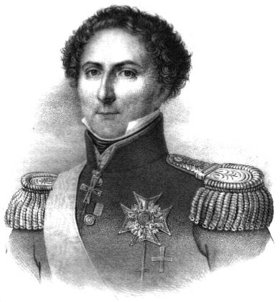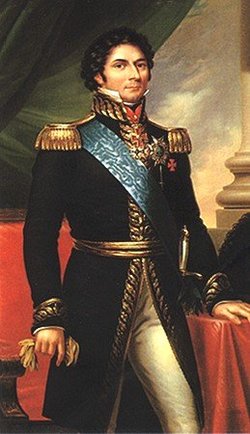Charles XIV of Sweden
|
|
King Charles XIV of Sweden, Charles III of Norway, or domestically Karl XIV Johan and Carl III Johan respectively, Jean Baptiste Jules Bernadotte (January 26, 1763 – March 8, 1844) was born at Pau, France, the son of Henri Bernadotte (1711-1780), procurator at Pau, and Jeanne St. Jean (1725-1809). His Christian names were Jean Baptiste (the Jules, from Julius Caesar, was added later, in the spirit of the French Revolution). The family name was originally Deu Pouey, but was changed into Bernadotte at the beginning of the 17th century.
| Reign | February 5, 1818-March 8, 1844 |
| Coronation | On May 11, 1818 in Sweden. On September 7, 1818 in Norway. |
| Royal motto | "Folkets kärlek min belöning" ("The people's love my reward ") |
| Queen | Desirée Clary (known as Queen Desideria) |
| Royal House | Bernadotte |
| Predecessor | Charles XIII, as the Swedish title and Carl II, as the Norwegian title. |
| Successor | Oscar I of Sweden and Norway |
| Date of Birth | January 26, 1763 |
| Place of Birth | Pau, France |
| Date of Death | March 8, 1844 |
| Place of Death | Royal Palace in Stockholm |
| Place of Burial | Riddarholmskyrkan, Stockholm |
| Contents |
Military career
Bernadotte entered the French Army on September 3, 1780, and first saw service in Corsica. On the outbreak of the French Revolution his eminent military qualities brought him speedy promotion. In 1794 we find him as brigadier attached to the army of the Sambre et Meuse, and after Jourdan's victory at Fleurus (26 June 1794) he became a general of division. At the battle of Theiningen (1796), Bernadotte contributed, more than any one else, to the successful retreat of the French army over the Rhine after its defeat by the Archduke Charles of Austria. In 1797 he brought reinforcements from the Rhine to Bonaparte's army in Italy, distinguishing himself greatly at the passage of the Tagliamento, and in 1798 served as ambassador to Vienna, but had to quit his post owing to the disturbances caused by his hoisting the tricolour over the embassy.
On 16 August 1798 he married Desirée Clary (1777-1860), the daughter of a Marseilles silk merchant, and sister of Joseph Bonaparte's wife Julie Clary. From July 2 to September 14 he was Minister of War, in which capacity he displayed great ability. About this time he held aloof from Bonaparte, but though he declined to help Napoleon in the preparations for the coup d'état of November 1799, he accepted employment from the Consulate, and from April 1800 to August 18, 1801 commanded the army in the Vendée.
On the introduction of the Empire Bernadotte became one of the eighteen Marshals of France, and, from June 1804 to September 1805, he acted as governor of the recently-occupied Hanover. During the campaign of 1805, Bernadotte with an army corps from Hanover co-operated in the great movement which resulted in the shutting up of Mack in Ulm. As a reward for his services at Austerlitz (December 2, 1805) he became Prince of Ponte Corvo (June 5, 1806), but during the campaign against Prussia, in the same year, was severely reproached by Napoleon for not participating with his army corps in the battles of Jena and Auerstädt, though close at hand. In 1808, as governor of the Hanseatic towns, he was to have directed the expedition against Sweden, via the Danish islands, but the plan came to nought because of the want of transports and the defection of the Spanish contingent. In the war against Austria, Bernadotte led the Saxon contingent at the Battle of Wagram (6 July 1809), on which occasion, on his own initiative, he issued an order of the day attributing the victory principally to the valour of his Saxons, which order Napoleon at once disavowed. It was during the middle of that battle that Marshal Bernadotte was stripped of his command after retreating against Napoleon's orders.
Offer of the Swedish throne
Bernadotte, considerably piqued, thereupon returned to Paris, where the council of ministers entrusted him with the defence of the Netherlands against the English. In 1810 he was about to enter upon his new post of governor of Rome when he was, unexpectedly, elected heir to King Charles XIII of Sweden, partly because a large part of the Swedish Army, in view of future complications with Russia, were in favour of electing a soldier, and partly because Bernadotte was very popular in Sweden, owing to the kindness he had shown to the Swedish prisoners during the late war with Denmark. The matter was decided by one of the Swedish couriers, Baron Karl Otto Mörner, who, entirely on his own initiative, offered the succession to the Swedish crown to Bernadotte. Bernadotte communicated Mörner's offer to Napoleon, who treated the whole affair as an absurdity. Bernadotte thereupon informed Mörner that he would not refuse the honour if he were duly elected. Although the Swedish government, amazed at Mörner's effrontery, at once placed him under arrest on his return to Sweden, the candidature of Bernadotte gradually gained favour there, and, on August 21, 1810, he was elected Crown Prince.
Crown Prince and Regent
On the November 2 Bernadotte made his solemn entry into Stockholm, and on the November 5 he received the homage of the estates and was adopted by Charles XIII under the name of "Charles John". The new crown prince was very soon the most popular and the most powerful man in Sweden. The infirmity of the old king and the dissensions in the Privy Council placed the government, and especially the control of foreign affairs, entirely in his hands. The keynote of his whole policy was the acquisition of Norway and Bernadotte proved anything but a puppet of France. In 1813 he allied Sweden with Napoleon's enemies Britain and Prussia of the Sixth Coalition, in order to secure this. After the defeats of Lützen (2 May 1813) and Bautzen (21 May 1813), it was the Swedish crown prince who put fresh heart into the allies; and at the conference of Trachenberg he drew up the general plan for the campaign which began after the expiration of the truce of Plaswitz. Charles John, as commander-in-chief of the northern army, successfully defended the approaches to Berlin against Oudinot in August and against Ney in September; but after Leipzig he went his own way, determined at all hazards to cripple Denmark and secure Norway.
King of Sweden and Norway
As unional king, Charles XIV John, who succeeded to that title in 1818 following the death of Charles XIII, was popular in both countries. Though his ultra-conservative views were detested, and as far as possible opposed, especially after 1823, his dynasty was never in serious danger, and Swedes and Norwegians alike were proud of a monarch with a European reputation. It is true that the Riksdag of the Estates of 1840 meditated compelling him to abdicate, but the storm blew over and his jubilee was celebrated with great enthusiasm in 1843. His reign saw the completion of the southern Göta kanal begun 22 years earlier to link Lake Vänern to the sea at Söderköping 180 miles to the east. Though he converted from Catholicism to the Lutheranism of the Swedish court on his adoption, he never learned to speak Swedish nor Norwegian. This in itself was not a serious obstacle for either King or Court. The Court had no problem with speaking French as it had been a favorite language in the Aristocracy for many years and was widely spoken in those days.
He died at Stockholm on March 8, 1844. His reign was one of uninterrupted peace, and the great material development of the two kingdoms during the first half of the 19th century was largely due to his energy and foresight. He was succeeded by his son, Oscar I of Sweden and Norway.
After his death a tattoo was found on his body saying "Mort aux rois!" ("Death to kings!") which was made (most likely) during French Revolution.
See also
External links
- Bernadotte (http://www.napoleonguide.com/marshal_bernadotte.htm) at Napoleonic Guide
| Preceded by: Charles XIII/ Carl II | King of Sweden 1818-1844 | Succeeded by: Oscar I 1818-1844 |
| King of Norway 1818-1844 |
de:Karl XIV. fr:Charles XIV Jean de Suède nl:Karel XIV van Zweden ja:ベルナドット no:Karl III Johan fi:Kaarle XIV Juhana sv:Karl XIV Johan pl:Karol XIV Jan


